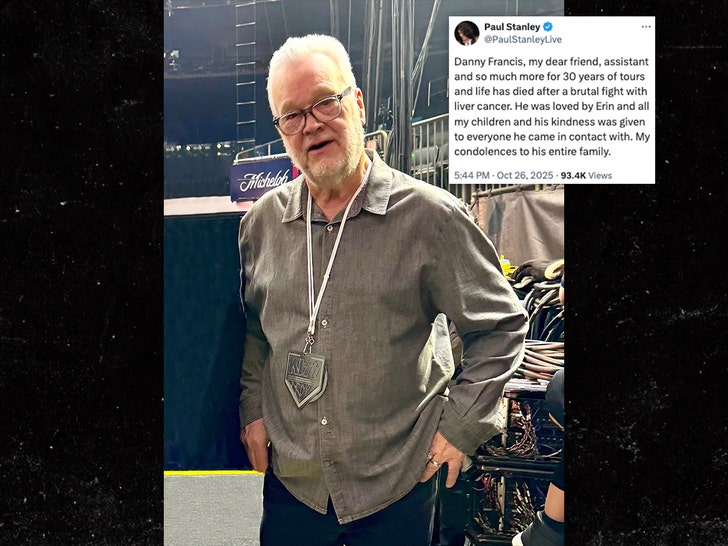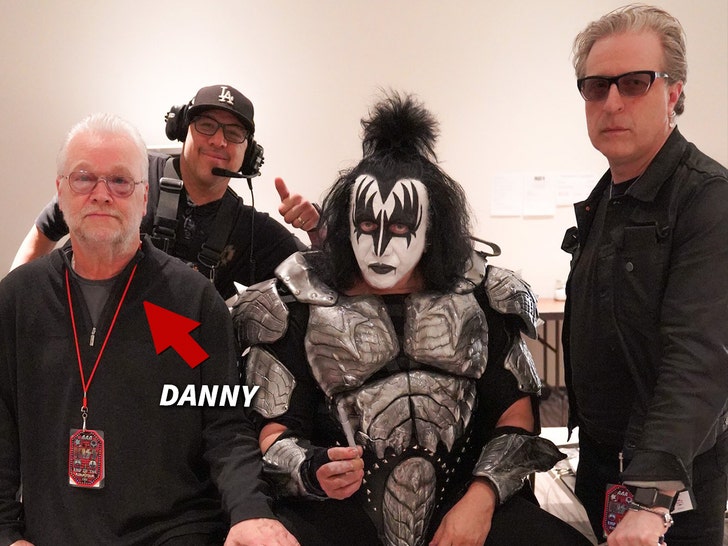Lifestyle
Head of Security for KISS Dies After ‘Brutal Fight’ With Cancer

KISS Head of Security
Dies After ‘Brutal Fight’ With Cancer
Published
KISS has suffered another blow … Danny Francis, the legendary band’s head of security, has passed away.

Co-lead vocalist, Paul Stanley, 73, made the announcement on X, writing, “Danny Francis, my dear friend, assistant and so much more for 30 years of tours and life has died after a brutal fight with liver cancer. He was loved by Erin and all my children and his kindness was given to everyone he came in contact with. My condolences to his entire family.”

This comes as Stanley and the rest of the band are still mourning the sudden loss of guitarist Ace Frehley.
We broke the story … Ace was hospitalized after falling and hitting his head at the studio last month, causing a brain bleed. His family made the difficult decision to take him off life support about over a week ago. He was 74.
The silver lining of all this tragic loss is it seems to be bringing the former bandmates together after their “farewell” tour in 2023. The surviving members, Gene Simmons, Stanley, and Peter Criss, congregated to pay their respects to Ace at his private funeral.
At the time, radio DJ and close friend of the band Eddie Trunk, posted, “All of the services went as well as they could and were attended by a small group of family and close friends … His family did give me the okay to pursue a tribute show/fan celebration at some point.”

Lifestyle
Why Cameron Crowe wears ‘uncool’ as a badge of honor

Cameron Crowe, left, speaks with Gregg Allman in 1973.
Neal Preston/Simon & Schuster
hide caption
toggle caption
Neal Preston/Simon & Schuster
If filmmaker Cameron Crowe’s career arc sounds like a Hollywood story, that’s because it is one. Crowe’s 2000 Oscar-winning film Almost Famous is based on his own teen years; he was 15 years old in 1973 when he became a music journalist, landing a backstage interview Gregg Allman. By age 16, he had written his first cover story for Rolling Stone. He’d go on to write about David Bowie, Jimmy Page and other rock stars.
Crowe credits much of his early success with his hometown of San Diego, which tended to come at the end of a band’s tour. By that time, he says, musicians were open to talking.
“Here’s a kid that comes to the door with a notebook full of questions based on the music that nobody was really asking them about,” Crowe says. “They’re like, ‘Get that kid in here. Come on, we’re bored. Let him ask us those questions.’”
In his new memoir, The Uncool, Crowe reflects on his adventures and misadventures as a teenage journalist. He also writes about what life was like in his family, and how he convinced his parents to allow him to go on the road before he’d even graduated high school.
The book is based in part on Crowe’s old interview tapes, which he saved. Listening back now, he says, those conversations informed his work as a Hollywood writer and director, whose credits include Fast Times at Ridgemont High, Say Anything … and Jerry Maguire.
“I transcribed all my interviews myself, so I knew that people don’t talk elegantly, but they can pour their heart out in half sentences,” he says. “So it was really one big magic carpet ride of learning about people. And it started early. I’m a lucky guy.”
Interview highlights

On interviewing musicians who were only a few years older than he was
I thought they were seasoned adults at the time. … They were 22, for example. And being 15, the distance between 15 and 22 is enormous. It’s like a generation. But really, we were all kind of young together, and rock was young. There wasn’t video assists and all the bells and whistles and dancers and stuff. It was really just a naked stage and people playing songs. And the power of the songs was the power of the concert. … But as a young guy, you’re kind of in this position where this person is allowing me to ask them whatever I want to about music that I love. And it was a blissful time and I still love writing about it.
On his mom’s reluctance to let him tour with rock bands
As a teacher and a counselor who had many great counselees who loved her so much, she always respected intellectualism. So if I could somehow pin it to intellectual success I had a way in. So to go on the road with Led Zeppelin at 15, I had to really sell Led Zeppelin to her as like music that’s based on Tolkien. And this is, like, lofty material that’s good for the soul. And ultimately, I think she said: Because we love the interviewer Dick Cavett in our family, go and take this journey, put on your magic shoes, call me every night, and don’t take drugs.” And that was my ticket out.
On being offered drugs
I learned early on, Terry, that like the best response is no. Because the person offering you the drugs generally then says, “Smart kid, more for me.” And that made me, I don’t know, it made people know that I wasn’t there to join the band, party with the band. I was there with a notebook full of questions based on loving music. And that really swung the door open in many ways.
On interviewing David Bowie in 1976

I asked him at one point, because his real name was David Jones, right? So I asked them at one point, “Am I meeting David Jones or am I meet David Bowie, the creation?” And he said, “You’re meeting David Jones who’s aggressively throwing David Bowie at you.” I asked at one time, I was like, “How do you think you’re gonna die? Do you think you’ll die on stage?” Because Ziggy Stardust, one of his characters, I think was based on somebody who had died on stage. And he said, “No, no no, I don’t think that’s going to happen to me.” I’m paraphrasing a little bit — but he said, “I think my death will be an event, something that I manage and produce and make my own statement.”

Crowe’s new memoir is based on interview tapes from the 1970s, which he saved.
Cameron Crowe/Simon & Schuster
hide caption
toggle caption
Cameron Crowe/Simon & Schuster
And that is exactly what happened. … He died of cancer at a young age and he knew he was dying. And what he did was didn’t tell anybody except a small group of collaborators. And he did this album, Black Star, which is his statement about the death that was coming. And it’s profound and it’s managed. And it is an opportunity that he did not throw away. He made a statement about his death.
On how the groupies would confide in him
All of the so-called “groupies,” or people that were hanging around the bands, women in particular, would, because I was so young, would confide in me. So I had no romantic potential or any of that. So they would actually be like magpies with me and just telling me all their stories and like, “I was really upset when he treated me like this” and “blah, blah, but you know what, you move on, you do this.” And I just I was like, wow. Nobody in high school ever talked to me like this. This is a glimpse of romantic bliss, minefields and all kinds of stuff.
On what he learned from Rolling Stone journalist Lester Bangs about being “uncool” — which was portrayed in a scene from Crowe’s semi-autobiographical film, Almost Famous

I was always trying to figure out what cool was, because my mom skipped me too many grades. I got my high school diploma in the mail, because I graduated as a junior. And the attempt to be cool … was never gonna pay off if you’re younger than everybody else. But what Lester was saying was … when you’re posturing, you’re never there. He said that they had done that to music. They had made music a lifestyle posture, not the thing that’s ripped from the soul. …
YouTube
And I thought, wow, so many of the musicians and the writers and the people that I came to love were not cool. … It was like a lost pursuit, but they found each other through music. They found each through this thing that gave you that feeling of being understood. So I called the book The Uncool because it was the badge of honor that Lester put on me, you know? Don’t try and do it. Be whatever is real to you. And that might be cool.
Sam Briger and Anna Bauman produced and edited this interview for broadcast. Bridget Bentz, Molly Seavy-Nesper and Beth Novey adapted it for the web.
Lifestyle
German police bust an art forgery ring trying to sell fake Picasso, Rembrandt works

Two forged artworks purportedly by the Spanish artist Pablo Picasso are seen during a presentation at the Bavarian State Criminal Investigation Department in Munich on Friday.
Matthias Balk/AFP via Getty Images
hide caption
toggle caption
Matthias Balk/AFP via Getty Images
German police say they’ve broken up an international art forgery ring that tried to sell works purportedly by Pablo Picasso, Rembrandt, Frida Kahlo and others for tens of millions of dollars to unsuspecting collectors.
The scheme was allegedly led by a 77-year-old German man from Bavaria with the help of ten accomplices, according to a press release from the Bavarian State Criminal Police Office.

Patrick Haggenmueller, head of the Art Investigation Unit of the Bavarian State Criminal Police Office (BLKA), stands next to the fake painting Mary with Child supposedly by Flemish painter Anthony van Dyck.
Matthias Balk/AFP via Getty Images
hide caption
toggle caption
Matthias Balk/AFP via Getty Images
Investigators say they discovered the fraud when the main suspect tried to sell two supposedly original Picasso works, including a portrait of the Spanish painter’s muse Dora Maar. (A Picasso painting of Maar entitled Bust of a Woman with a Flowered Hat sold last week for around $37 million, after having been held in a family collection since it was purchased in 1944.)
The unnamed ringleader apparently also tried to sell a copy of a world-famous painting by the Dutch painter Rembrandt van Rijn known as The Syndics, a 17th century portrait of members of Amsterdam’s cloth makers’ guild, for roughly $150 million. But the original of that painting, known in Dutch as De Staalmeesters, sits in the collection of the Rijksmuseum in Amsterdam.
Police say the fake was likely a copy from the 20th century owned by an 84-year-old Swiss woman, who is now also under investigation by German and Swiss authorities.

Authorities say the 77-year-old main suspect tried to sell a Rembrandt painting known as The Syndics. That work, known in Dutch as De Staalmeesters, is part of the collection of Amsterdam’s Rijksmuseum.
Matthias Balk/AFP via Getty Images
hide caption
toggle caption
Matthias Balk/AFP via Getty Images
Other phony works allegedly offered for sale by the 77-year-old suspect included ceramic vases by Picasso, Study of a Head by Amadeo Modigliani, and pieces purportedly by Peter Paul Rubens, Joan Miró and Anthony van Dyck. Purchase prices ranged from about $460,000 to more than $16 million.
One accomplice in the scheme was a 74-year-old man from Rhineland-Palatinate who produced counterfeit expert reports attesting to the authenticity of the forgeries, investigators say.
A coordinated series of searches by police one morning earlier this month at more than a dozen locations in Germany, Switzerland and Lichtenstein yielded a number of suspected forgeries, which are set to be analyzed by art experts in the coming weeks.
Lifestyle
The Debrief | Does Fashion Still Know What Women Want?

-

 New York4 days ago
New York4 days agoVideo: How Mamdani Has Evolved in the Mayoral Race
-

 World7 days ago
World7 days agoIsrael continues deadly Gaza truce breaches as US seeks to strengthen deal
-

 News6 days ago
News6 days agoVideo: Federal Agents Detain Man During New York City Raid
-

 News6 days ago
News6 days agoBooks about race and gender to be returned to school libraries on some military bases
-

 Technology7 days ago
Technology7 days agoAI girlfriend apps leak millions of private chats
-

 Politics7 days ago
Politics7 days agoTrump admin on pace to shatter deportation record by end of first year: ‘Just the beginning’
-

 News7 days ago
News7 days agoTrump news at a glance: president can send national guard to Portland, for now
-

 Business7 days ago
Business7 days agoUnionized baristas want Olympics to drop Starbucks as its ‘official coffee partner’














